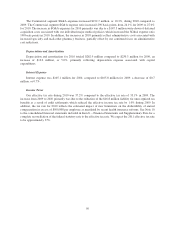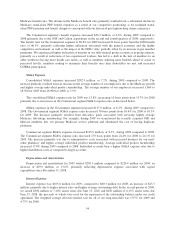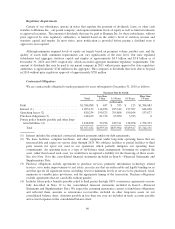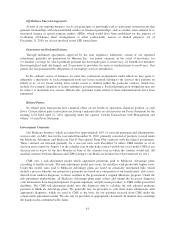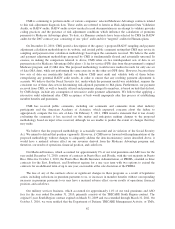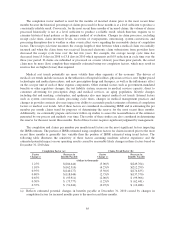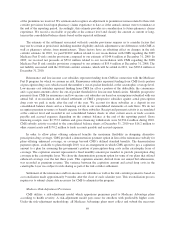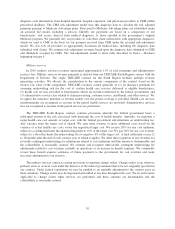Humana 2010 Annual Report Download - page 70
Download and view the complete annual report
Please find page 70 of the 2010 Humana annual report below. You can navigate through the pages in the report by either clicking on the pages listed below, or by using the keyword search tool below to find specific information within the annual report.
Regulatory Requirements
Certain of our subsidiaries operate in states that regulate the payment of dividends, loans, or other cash
transfers to Humana Inc., our parent company, and require minimum levels of equity as well as limit investments
to approved securities. The amount of dividends that may be paid to Humana Inc. by these subsidiaries, without
prior approval by state regulatory authorities, is limited based on the entity’s level of statutory income and
statutory capital and surplus. In most states, prior notification is provided before paying a dividend even if
approval is not required.
Although minimum required levels of equity are largely based on premium volume, product mix, and the
quality of assets held, minimum requirements can vary significantly at the state level. Our state regulated
subsidiaries had aggregate statutory capital and surplus of approximately $4.3 billion and $3.8 billion as of
December 31, 2010 and 2009, respectively, which exceeded aggregate minimum regulatory requirements. The
amount of dividends that may be paid to our parent company in 2011 without prior approval by state regulatory
authorities is approximately $740 million in the aggregate. This compares to dividends that were able to be paid
in 2010 without prior regulatory approval of approximately $720 million.
Contractual Obligations
We are contractually obligated to make payments for years subsequent to December 31, 2010 as follows:
Payments Due by Period
Total
Less than
1 Year 1-3 Years 3-5 Years
More than
5 Years
(in thousands)
Debt .................................. $1,586,988 $ 447 $ 333 $ 125 $1,586,083
Interest (1) ............................. 1,203,133 114,226 225,342 217,507 646,058
Operating leases (2) ...................... 810,234 190,525 295,868 190,164 133,677
Purchase obligations (3) ................... 148,169 81,376 63,050 3,743 0
Future policy benefits payable and other long-
term liabilities (4) ...................... 1,818,658 52,936 249,311 138,078 1,378,333
Total .............................. $5,567,182 $439,510 $833,904 $549,617 $3,744,151
(1) Interest includes the estimated contractual interest payments under our debt agreements.
(2) We lease facilities, computer hardware, and other equipment under long-term operating leases that are
noncancelable and expire on various dates through 2025. We sublease facilities or partial facilities to third
party tenants for space not used in our operations which partially mitigates our operating lease
commitments. An operating lease is a type of off-balance sheet arrangement. Assuming we acquired the
asset, rather than leased such asset, we would have recognized a liability for the financing of these assets.
See also Note 16 to the consolidated financial statements included in Item 8.—Financial Statements and
Supplementary Data.
(3) Purchase obligations include agreements to purchase services, primarily information technology related
services, or to make improvements to real estate, in each case that are enforceable and legally binding on us
and that specify all significant terms, including: fixed or minimum levels of service to be purchased; fixed,
minimum or variable price provisions; and the appropriate timing of the transaction. Purchase obligations
exclude agreements that are cancelable without penalty.
(4) Includes future policy benefits payable ceded to third parties through 100% coinsurance agreements as more
fully described in Note 19 to the consolidated financial statements included in Item 8.—Financial
Statements and Supplementary Data. We expect the assuming reinsurance carriers to fund these obligations
and reflected these amounts as reinsurance recoverables included in other long-term assets on our
consolidated balance sheet. Amounts payable in less than one year are included in trade accounts payable
and accrued expenses in the consolidated balance sheet.
60


